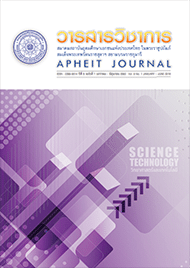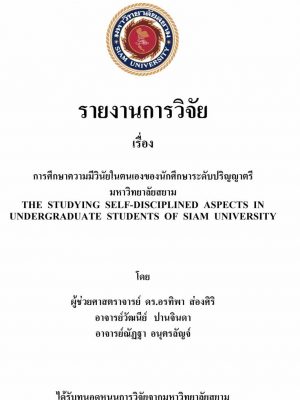
An Analysis of the Relationship of Social Application Usage on Academic Achievement of Nursing Students, Siam University (2016)
Title : An Analysis of the Relationship of Social Application Usage on Academic Achievement of Nursing Students, Siam University
Researcher : Assist. Prof. Dr. Jaratdao Reynolds, Assist. Prof. Dr. Orntipa Songsiri and Assist. Prof. Dr. Somrudee Chenkitiyanon
Department : Faculty of Nursing, Siam University, Bangkok, Thailand
E-mail : jaratdao@gmail.com
Abstract : As we enter the 21st century, social application/networking is being used by an increasing portion of world’s population, especially adolescents and young adult on a day- to-day regular activities. Students are increasingly uses these social application /networks for both academic and non-academic reasons. However, the use of this social application has led to debate over whether or not it has impacted on students’ life as well as their academic achievement. Some studies identified that social application/networking may be the tool used in helping to develop and enhance students’ skill required for 21st century (Tuan and tu,2013). Therefore, this study was aimed to explore the relationship of social application usage among nursing students on their academic performance (GPAs). It took into account on how students participated on socialn application, time invested by students on social application, frequency of usage and the purposes of usage. The study was a cross-sectional survey, using the developed questionnaire. The data was collected from 272 students in the second and fourth year of nursing program, Siam University during the academic year 2014-2015. The data were statistically analyzed by calculating percentage, mean, standard deviation, and Pearson correlation analysis. Results indicated that all of the nursing students were using at least one form of social application. For the use of social applications, it was obviously that, Facebook and Line were the most popular social application students used (100%), followed by google (89.7%) and instragram (57.57%).Results of frequency of usage indicated that 98.16 percent of students visited a social application/networking several times a day. In term of the purposed for using the social applications, they were varied. Even though students generally use social application for academic purposes; they also use it for nonacademic matters .For non academic purposed, the results shown that 94.12 percent of students reported used the social applications for communication with friends and family, and 72.80 percent reported they used for entertainment when they felt bored. Additional reasons reported included companionship (47.06%), and making friends (27.21%). For academic purposed, searching for information was the most reason students used (77.95%), followed by learning and sharing resources (66.91%), exchange ideas and discussion (48.16%) and professional networking (36.03%) respectively. The finding of this study found negative correlations between time spent on social application usage with students’ GPAs. In other words, GPAs decreased as the amount of time spent on social application usage. The purposes of usage was also shown to be significantly correlated with students’ GPAs. The students who use social application for academic purposes seem to earned better GPAs.Therefore, in the light of globalization and the information age, integration of these social application in students’ life is unavoidable,however findingmiddle ground has become a challenge.
Proceeding : การประชุมวิชาการระดับชาติ สมาคมสถาบันอุดมศึกษาเอกชนแห่งประเทศไทย ประจำปี 2559 วันที่ 26 พฤษภาคม 2559 มหาวิทยาลัยภาคตะวันออกเฉียงเหนือ APHEIT Conference 2016
Link to Proceeding: http://apheitconference.siam.edu/index.php/en/proceedings-2012-2016
Bibliography : Jaratdao Reynolds, Orntipa Songsiri & Somrudee Chenkitiyanon. (2016). An analysis of the relationship of social application usage on academic achievement of nursing students, Siam University. In Proceedings of Conference 2016 (pp. 170-171). Khon Kaen: North Eastern University.

การพัฒนารูปแบบการสร้างเสริมสุขภาพจิตในชุมชน ด้วยกระบวนการวิจัยปฏิบัติการแบบมีส่วนร่วม: กรณีศึกษาชุมชนหนึ่ง ในกรุงเทพมหานคร (2562)
Title : การพัฒนารูปแบบการสร้างเสริมสุขภาพจิตในชุมชน ด้วยกระบวนการวิจัยปฏิบัติการแบบมีส่วนร่วม: กรณีศึกษาชุมชนหนึ่ง ในกรุงเทพมหานคร : Development of Mental Health Promotion Model in Community by Participatory Action Research Process: Case Study of a Community in Bangkok
Researcher : Susaree Prakhinkit, Jarusdaw Renold, Orntipa Songsiri
สุสารี ประคินกิจ, จรัสดาว เรลโนลด์, อรทิพา ส่องศิริ
Department : คณะพยาบาลศาสตร์ มหาวิทยาลัยสยาม
E-mail : tik.susaree@gmail.com
บทคัดย่อ : การวิจัยนี้เป็นการวิจัยเชิงปฏิบัติการแบบมีส่วนร่วม เพื่อพัฒนารูปแบบการสร้างเสริมสุขภาพจิตในชุมชน มีผู้เกี่ยวข้องจำนวน 38 คน ประกอบด้วยเจ้าหน้าที่สาธารณสุขอาสาสมัครสาธารณสุขอาจารย์พยาบาลสมาชิกในชุมชน ระยะเวลาดำเนินการ เดือนมิถุนายน พ.ศ. 2558 ถึง พฤษภาคม พ.ศ. 2559 ใช้การสัมภาษณ์เชิงลึกเวทีประชาคม เสวนากลุ่มย่อย การสังเกต และการถอดบทเรียน วิเคราะห์ข้อมูลด้วยการวิเคราะห์เชิงเนื้อหาและสถิติเชิงพรรณนา พบว่า รูปแบบการสร้างเสริมสุขภาพ ประกอบด้วย4องค์ประกอบ ได้แก่ปัจจัยด้านผู้นำชุมชน อิทธิพลระหว่างบุคคล ปัจจัยด้านตัวบุคคล อิทธิพลด้านสถานการณ์สอดคล้องกับแบบส่งเสริมสุขภาพของเพนเดอร์ (2002) ภายหลังสิ้นสุดโครงการ สมาชิกในชุมชนมีความสุขในระดับปกติมากขึ้น และมีคุณภาพชีวิตในระดับดีสมาชิกให้ความสนใจเข้าร่วมกิจกรรมผ่อนคลายความเครียดเห็นความสำคัญของการมีสัมพันธภาพที่ดีภายในครอบครัวผู้ป่วยจิตเวชรับประทานยาตามแพทย์สั่งอย่างเคร่งครัดและสามารถเผชิญกับความเครียดอย่างมีประสิทธิภาพขึ้น
คําสําคัญ : การสร้างเสริมสุขภาพจิต กระบวนการมีส่วนร่วม ชุมชน กรุงเทพมหานคร
Abstract : The research was participatory actionresearch.Theobjective was to develop a model of mental health promotion in community. The thirty-eight participants including nurses of public health service center, nursing instructor, village health volunteers and members community joined this study. This research was conducted during June 2015 to May 2016. Theresearchinstruments werein-depthinterviews, civil society forum, small group discussion,
observation, and lesson learned visualizing. Content Analysis was used to analyze qualitative data, while descriptive statistics were performed for quantitative data. The results found that the model mental health promoting was composed of four factors; community leader factors, interpersonal influence, personal factors and situational influence. These 4 factors corresponded well with the model of Pander (2002). At the end of the research members community reported having improved happiness and qualityof life. They were interested and participated inrelaxationactivities. They were awareof good family relationship. Patients with mental disorder took medicine as prescribed by the doctor and dealt with stress effectively.
Keywords : Mental Health Promotion, Participatory Process, Community, Bangkok
Link to Publication : วารสารวิชาการสมาคมสถาบันอุดมศึกษาเอกชนแห่งประเทศไทยฯ ฉบับวิทยาศาสตร์และเทคโนโลยี ปีที่ 8 ฉบับที่ 1 เดือนมกราคม-มิถุนายน 2562
Bibliography : สุสารี ประคินกิจ, จรัสดาว เรลโนลด์ และ อรทิพา ส่องศิริ . (2562). การพัฒนารูปแบบการสร้างเสริมสุขภาพจิตในชุมชน ด้วยกระบวนการวิจัยปฏิบัติการแบบมีส่วนร่วม: กรณีศึกษาชุมชนหนึ่ง ในกรุงเทพมหานคร. วารสารวิชาการสมาคมสถาบันอุดมศึกษาเอกชนแห่งประเทศไทย ฉบับวิทยาศาสตร์และเทคโนโลยี , 8(1), 7-17.

การศึกษาความมีวินัยในตนเองของนักศึกษาระดับปริญญาตรี มหาวิทยาลัยสยาม (2548)
Title : การศึกษาความมีวินัยในตนเองของนักศึกษาระดับปริญญาตรี มหาวิทยาลัยสยาม: THE STUDYING SELF-DISCIPLINED ASPECTS IN UNDERGRADUATE STUDENTS OF SIAM UNIVERSITY
Researcher : ผู้ช่วยศาสตราจารย์ ดร.อรทิพา ส่องศิริ อาจารย์วัฒนีย์ ปานจินดา อาจารย์ณัฏฐา อนุตรลัญจ์
Department : Faculty of Nursing, Siam University, Bangkok, Thailand
E-mail : jsiamns@siam.edu
บทคัดย่อ : การวิจัยครั้งนี้เป็นการวิจัยเชิงบรรยายมีวัตถุประสงค์ เพื่อศึกษาความมีวินัยในตนเองของนักศึกษาระดับปริญญาตรีมหาวิทยาลัยสยาม โดยรวมและเป็นรายด้าน 7 ด้าน ได้แก่ ความรับผิดชอบ ความเชื่อมั่นในตนเอง ความเป็นผู้นํา ความอดทน ความซื่อสัตย์ ความเสียสละและการรักษาระเบียบใจ กลุ่มตัวอย่างเป็นนักศึกษาที่กําลังศึกษาในระดับปริญญาตรี มหาวิทยาลัยสยาม จํานวน 531 คน ทําการสุ่มกลุ่มตัวอย่างด้วยวิธีการสุ่มแบบแบ่งชั้น (Stratified random sampling) เครื่องมือในการวิจัย คือ แบบสอบถามความมีวินัยในตนเองของนักศึกษาระดับปริญญาตรี มีค่าความเชื่อมั่นของแบบสอบถามเท่ากับ 0.89 วิเคราะห์ข้อมูลโดยใช้สถิติ t-test, F-test และทดสอบความแตกต่างเป็นรายคู่โดยวิธีการของเชฟเฟ่ ผลการวิจัยสรุปได้ดังนี้
1) นักศึกษาระดับปริญญาตรี มหาวิทยาลัยสยาม มีความมีวินัยในตนเองโดยรวมอยู่ในระดับมาก เมื่อพิจารณาเป็นรายด้าน พบว่า นักศึกษามีความมีวินัยในตนเองด้านความเป็นผู้นํา ความรับผิดชอบ ความอดทน ความซื่อสัตย์ ความเสียสละ และการรักษาระเบียบใจอยู่ในระดับมาก ยกเว้นด้านความเชื่อมั่นในตนเองอยู่ในระดับปานกลาง
2) ค่าเฉลี่ยของความมีวินัยในตนเองโดยรวมของนักศึกษาหญิงสูงกว่านักศึกษาชาย อย่างมีนัยสําคัญทางสถิติที่ระดับ .05
3) นักศึกษาแต่ละคณะ ระดับชั้น ความเข้มงวดในการมีระเบียบวินัยของคณาจารย์ ลักษณะการอบรมเลี้ยงดูต่างกัน มีความมีวินัยในตนเองโดยรวมแตกต่างกันอย่างมีนัยสําคัญทางสถิติที่ระดับ .05
คำสำคัญ : ความมีวินัยในตนเอง นักศึกษา
Abstract : The study was descriptive research. The purpose of this study was to determine self-disciplined aspects in undergraduate students of Siam University The self-disciplined aspects composed of responsibility, self-confidence, leadership, patience, honesty, sacrifice and reserving one’s attitude. The subjects were 531 undergraduate students of Siam University that were required from stratified random sampling. The instrument was the self-disciplined aspects questionnaire of undergraduate students that had interrater reliability of 0.89. Data was analyzed by t-test, F-test, and Major finding were as follows:
1) The undergraduate students of Siam University have had the high level of self- disciplined aspects. Considering each an aspect has found that they had the high level in leadership, responsibility, patience, honesty, sacrifice and reserving one’s attitude but they had the moderate level of self-confidence.
2) The mean score of self- disciplined aspects of the female group were significantly higher than the male group at the .05 level.
3) The self- disciplined aspects were significantly different at the .05 level in the difference of grade, the strict-disciplined of instructors on student and admonishment of parents.
Keywords : self- disciplined aspects, undergraduate students
Research : รายงานการวิจัย เรื่อง การศึกษาความมีวินัยในตนเองของนักศึกษาระดับปริญญาตรี มหาวิทยาลัยสยาม
Link to Research: http://www.research-system.siam.edu/2013-12-20-03-57-52/251-2013-12-20-05-58-109
Bibliography : อรทิพา ส่องศิริ, วัฒนีย์ ปานจินดา และ ณัฏฐา อนุตรลัญจ์. (2548). การศึกษาความมีวินัยในตนเองของนักศึกษาระดับปริญญาตรี มหาวิทยาลัยสยาม (รายงานการวิจัย). กรุงเทพฯ: มหาวิทยาลัยสยาม.

การเข้ามาทำงานโรงพยาบาลในประเทศไทยของบุคลากรต่างชาติ (2561)
Title : การเข้ามาทำงานโรงพยาบาลในประเทศไทยของบุคลากรต่างชาติ : Foreigners Employed as Hospital Workforce in Thailand
Researcher : รุ่งฤดี วงค์ชุม* พีรนุช ลาเซอร์* อรทิพา ส่องศิริ† พิชาภรณ์ จันทนกุล† วิชชุดา เจริญกิจการ‡ ชุติมา อรรคลีพันธุ์§
Department : *คณะพยาบาลศาสตร์แมคคอร์มิค มหาวิทยาลัยพายัพ †คณะพยาบาลศาสตร์ มหาวิทยาลัยสยาม ‡คณะพยาบาลศาสตร์ มหาวิทยาลัยมหิดล §สำนักงานพัฒนานโยบายสุขภาพระหว่างประเทศ
E-mail :
Abstract : The aims of the present descriptive study of foreigners being employed as hospital workforce in Thailand were to explore the characteristics of foreign hospital employees, factors influencing decision makingof foreigners seekingemployment inThailand, the processof beingemployed as foreignhospital
employees, and problems or obstacles encountered while working in Thailand. One hundred foreign hospital employees in both government and private hospitals inThailand were recruited using snowball sampling. A questionnaire was used for data collection. The data were analyzed using descriptive statis- tics, including frequency, percentage, mean, and standard deviation. The results revealed that most participants were females with the mean age of 31.23 years. Onethird of foreign hospital employees were the Filipinos. Success factors of being employed in Thailand included level of education (68%), competencies/special skills in needed fields (64%), and ability to communicate in Thai (55%). Factors influencing foreigners making decision to work in Thailand covered both push factors (such as low wages, limited career progression, unfair benefits, and high living expens- es) and pull factors (including gaining new experience, job opportunities, and opportunity to improve career).The processes for being employed as foreignhospital employees included 1) preparation phase: foreigners prepared on language, working knowledge and employment laws, and health check-ups 2) application phase: most foreigners applied for a job themselves after receiving information. A tourist visa was initially granted at first arrival in Thailand and then changed to a non-immigrant visa “B”. The expensesof application phaseincluded a visa, passport, work permit, and travel. Most participants (93%) were working as medical serviceassistants, suchas interpreters and 7% were qualified to work ashealth- care providers as described under the mutual recognition arrangement (MRA). Communication in Thai, adjusting to social and cultural differences, unfair wage, visa and work permit renewal were indicated as problems or obstacles encountered while working in Thailand. The recommendations from the present research were as follows: 1) stakeholders should revise the process of work permit renewal, and MRA; 2) the organization or employer should provide a basic training program in healthcare competencies, and improve workplace culture, including setting up ap- propriate remuneration system as international standard and equity basis.
Keywords : being employed, foreigners, foreign health workforce, hospital employees, Thailand
Link to Publication : วารสารวิจัยระบบสาธารณสุข Journal of Health Systems Research ปีที่ 12 ฉบับที่ 2 เม.ย.-มิ.ย. 2561
Bibliography : รุ่งฤดี วงค์ชุม, พีรนุช ลาเซอร์, อรทิพา ส่องศิริ, พิชาภรณ์ จันทนกุล, วิชชุดา เจริญกิจการ และ ชุติมา อรรคลีพันธุ์. (2561). การเข้ามาทำงานโรงพยาบาลในประเทศไทยของบุคลากรต่างชาติ.วารสารวิจัยระบบสาธารณสุข, 12(2), 292-305.